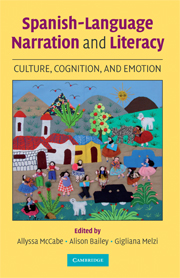Spanish-Language Narration and Literacy
This book is divided into three main topical sections: (1) Parent-child construction of narrative, which focuses on aspects of the social interaction that facilitate oral narrative development in Spanish-speaking children; (2) Developing independent narration by Spanish-speaking children; and (3) Narrative links between Latino children’s oral narration and their emergent literacy and other school achievements. Chapters address narration to and by Latino children aged six months to eleven years old and in low, middle, and upper socioeconomic groups. Nationalities of speakers include the following: Costa Rican, Dominican, Ecuadorian, Mexican, Peruvian, Puerto Rican, Venezuelan, and Spanish-English bilingual children who are citizens or residents of the United States. Narratives studied include those in conversations, personal and fictional stories, and those prompted by wordless picture books or videos. Thus, the current project includes diverse nationalities, socioeconomic backgrounds, and genres of narrative.
- Study of multiple populations of Spanish-speaking children in the Americas
- Examination of various types of narration in Spanish
- Consideration of Spanish-speakers at home (mothers, fathers and children) and at school
Reviews & endorsements
“If you teach Spanish-speaking children or conduct research on language development, you’ll want to own this timely and relevant book. The ability to create oral narratives—for instance to tell someone what happened at the park—is a necessary foundation for literacy. But children learn to construct narratives as they interact with those around them, and what is included or emphasized in the narrative varies by culture. Spanish-speaking children are sometimes misinterpreted when they are actually producing narratives that are typical and appropriate in Peru or Guatemala or the Dominican Republic. The book provides information and interesting examples that can help teachers use Latino children’s distinctive narrative skills in a positive and rewarding way. Researchers will want to read the carefully designed studies that contribute materially to the literature on discourse development.”
—Jean Berko Gleason, Boston University
"The research findings of the team assembled by Allyssa McCabe, Alison L. Bailey, and Gigliana Melzi open new vistas into the shaping of Latino culture through “talk” between caregivers and children. We become who we are through conversation. Our language is our identity. This is a scholarly contribution of the highest order!"
—Ilan Stavans, author of Spanglish: The Making of a New American Language
Product details
August 2008Paperback
9780521710046
382 pages
228 × 152 × 20 mm
0.53kg
20 tables
Available
Table of Contents
- 1. Introduction Alison Bailey, Allyssa McCabe and Gigliana Melzi
- Part I. Parent-Child Interaction:
- 2. Cultural variations in mother-child narrative discourse style Margaret Caspe and Gigliana Melzi
- 3. Early socio-communicative narrative patterns during Costa Rican mother-infant interaction Pablo Stansbery
- 4. Lessons in mother-child and father-child personal narratives in Latino families Tonia N. Cristofaro and Catherine S. Tamis-LeMonda
- 5. Evaluation in Spanish-speaking mother-child narratives: the social and sense-making function of internal state references Camila Fernández and Gigliana Melzi
- 6. Love, diminutives, and gender socialization in Andean mother-child narrative conversations Kendall A. King and Colleen Gallagher
- Part II. Developing Independent Narration:
- 7. The intersection of language and culture among Mexican-heritage children three to seven years old Alison Wishard Guerra
- 8. Beyond chronicity: evaluation and temporality in Spanish-speaking children's personal narratives Paola Uccelli
- 9. Narrative stance in Venezuelan children's stories Martha Shiro
- 10. Mestizaje: Afro-Caribbean and indigenous Costa Rican children's narratives and links with other traditions C. Nicholas Cuneo, Allyssa McCab, and Gigliana Melzi
- Part III. Links to Literacy and Other School Achievements:
- 11. Latino mothers and their preschool children talk about the past Alison Sparks
- 12. The contribution of Spanish-language narration to the assessment of early academic performance of Latino students Alison L. Bailey, Ani Moughamian and Mary Dingle
- 13. Cultural variation in narrative competence and its implications for children's academic success Sarah W. Beck.




